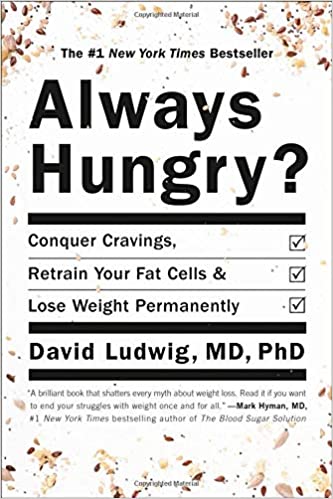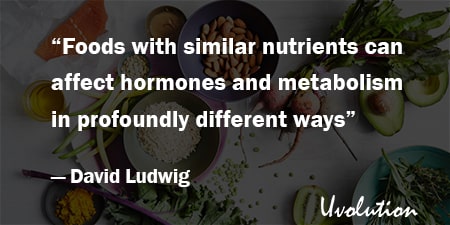Always Hungry by David Ludwig Book Summary
The Book in 1 Sentences
Always Hungry?: Conquer Cravings, Retrain Your Fat Cells, and Lose Weight Permanently
“Most weight loss programs require you to cut back on calories. This one won’t. Many expect you to endure hunger. This one doesn’t. Some require grueling workouts. Not this one.
That’s because the program in this book, the Always Hungry Solution, uses a radically different method of weight control, based on decades of groundbreaking, but little-known research.
Conventional diets aim to shrink body fat by restricting calorie intake. But this approach is doomed to fail in the real world, because it targets the symptoms, not the root cause of the problem. After a few weeks of calorie restriction, the body fights back, and makes us feel hungry, tired, and deprived.
Though we may be able to ignore these unpleasant feelings for a short while, they inevitably erode our motivation and willpower. Sooner or later, we succumb to temptation and the
weight comes racing back—often leaving us heavier than before we started the diet.
The Always Hungry Solution turns dieting on its head, by ignoring calories and targeting fat tissue directly. Using the right types and combinations of foods (and other supportive techniques related to stress reduction, sleep, and enjoyable physical activities), this approach reprograms fat cells to release their stored calories.
When this happens, the pent-up calories flood back into the body, shifting metabolism into weight loss mode. You’ll experience a surge in energy levels and dramatically increased satiety—that pleasant sense of fullness after eating. You’ll feel good, and begin to lose weight without hunger or cravings.” ~ David Ludwig, M.D., Ph.D
6 BIG Ideas
1. Different types of calories effect us differently
2. Low-fat diets have not worked
Always Hungry Book Summary
“The usual ‘eat less, move more’ approach misses the root cause of weight gain, produces side effects, and is destined to fail for most people. In this way, low-calorie diets may actually make matters worse.”
1. Different types of calories effect us differently
“The results were published in the American Journal of Clinical Nutrition. Similar to our first study, blood glucose and insulin levels were higher after the fast-acting milkshake for the first hour or two.
But by four hours after consuming the fast-acting shake, blood glucose fell to lower levels and reported hunger was greater, compared to the slow-acting shake.
At that time, we conducted brain imaging scans, using a technique called functional magnetic resonance imaging (fMRI). The scans detected one brain region, called the nucleus accumbens, that lit up like a laser after the fast-acting shake.
The effect was so strong and consistent, it occurred in every one of our participants, providing strong statistical confidence in the results. The nucleus accumbens is considered ground zero for reward, craving, and addiction—including alcohol, tobacco, and cocaine abuse.
Activation of this brain region on a weight loss diet would erode willpower, making that sticky bun exceedingly hard to resist.
The concept of food addiction is controversial because, unlike substances of abuse, we need food to live. However, this study suggests that highly processed carbohydrates may hijack basic reward circuitry in the brain, not because they are inherently so tasty (both milk shakes had the same sweetness), but instead because of direct actions on metabolism.
Hunger is hard enough to fight under any circumstances, but once the nucleus accumbens joins in, it’s all over.”
“Foods with similar nutrients can affect hormones and metabolism in profoundly different ways, determining whether we store or burn calories, build fat or muscle, feel hungry or satisfied, struggle with weight or maintain a healthy weight effortlessly, and suffer from or avoid chronic inflammation.”
2. Low-fat diets have not worked
“For fifty years, we’ve been told that a low-fat diet would protect us against chronic diseases. That notion inspired the Women’s Health Initiative clinical trial which started in 1991 (whose disappointing results were discussed in chapter 2) and also informed the design of the Look Ahead study, launched a decade later.
The goal of Look Ahead was to reduce heart disease, a common complication of diabetes. The study, conducted in sixteen clinical centers in the United States, assigned about five thousand adults with type 2 diabetes to either a low-fat diet with intensive lifestyle modification or to usual care.
The study, published in the New England Journal of Medicine in 2013, was terminated prematurely for ‘futility.’ Analysis by independent statisticians found no reduction of heart disease among participants assigned to the intensive low-fat diet, and no prospect of ever seeing such a benefit emerge.
By coincidence, another study called PREDIMED was published in the same prestigious journal the very same year. This study assigned about seven thousand five hundred Spanish adults with heart disease risk factors to one of three diets: Mediterranean with lots of olive oil, Mediterranean with lots of nuts, or a conventional low-fat diet.
The interventions did not involve a calorie restriction or weight loss goal. PREDIMED was also terminate early, but in this case because effectiveness exceeded expectations.
Both higher fat groups had such significant reductions in cardiovascular disease (about 30 percent) that continuation of the trial would have been unethical for the participants in the conventional group.
These two recent studies should seal the coffin on the standard low-fat diet. More broadly, they show that modest improvements in diet—specifically, more fat and less processed carbohydrates—can prevent obesity-related disease at any body weight. A high-quality diet seems to calm down ‘angry fat’ even without weight loss. With weight loss, the health benefits could be huge.”
“Ironically, the standard treatment for diabetes since the 1970s has been a low-fat, high-carbohydrate diet—the same diet that contributes to the problem in the first place! We wouldn’t give milk sugar lactose to someone with lactose intolerance. What’s the sense in giving so much carbohydrate to someone who, by definition, has carbohydrate intolerance?”
“Highly processed carbohydrates are among the lowest-quality components of the food supply, accounting for the majority of diet-related disease in the United States today—they’re highly concentrated in calories but devoid of real nutrition.”
3. Fast-acting carbs and ADD
“In a carefully controlled feeding study, researchers from the University of Wales in the United Kingdom gave seventy-one female undergraduates slow- or fast-digesting carbohydrate-based breakfasts and then tested their cognitive functioning.
They found that memory, especially for hard words, was impaired throughout the morning after the fast-digesting breakfast. This effect was most pronounced several hours after the meal (a 33 percent deficit).
Similar results were obtained in Toronto among twenty-one patients with diabetes. Following a meal with fast-digesting carbohydrate, verbal memory performance, working memory, selective attention, and executive function were worse compared to a meal containing the same amount of carbohydrate in slow-digesting form.
These cognitive deficits in children and young adults, if persistent, may lead to a diagnosis of attention-deficit disorder (ADD). Of course, there are many reasons why kids today may have difficulty concentrating, ranging from too much screen time to too little sleep. But these and other studies suggest that overconsumption of highly processed carbohydrates could be contributing to the problem.”
“Meals with the same calories can produce dramatically different outcomes a few hours later.”
4. Focus on eating the right foods
“Standard low-fat diets aim to squeeze calories out of fat cells by restricting calorie intake.
But after a few weeks of deprivation, hunger skyrockets and metabolism slows. The problem is, cutting calories does nothing to address the underlying cause of weight gain.
The Always Hungry Solution targets weight gain at its sources—fat cells stuck in calorie-storage overdrive. By decreasing insulin levels and calming chronic inflammation, we can reprogram fat cells to release excess calories.
When this happens, hunger diminishes, cravings subside, metabolism speeds up, and you lose weight naturally.
We’ll do this through three progressive phases:
•Phase 1—A two-week boot camp to conquer cravings and jump-start weight loss.
•Phase 2—A hunger-free plan to retrain your fat cells and reach your new, lower body weight set point. This can last anywhere from several weeks to six months or more, depending upon how much weight you have to lose.
• Phase 3—A customized diet for your body’s unique needs so you can keep the weight off permanently.”
“You’ll completely abandon the calorie-counting approach to weight loss. Instead, you’ll focus on eating the right foods in the right combinations to reprogram fat cells so they release their excess calorie stores.
The fastest way to do this is by replacing refined carbohydrates (the primary driver of insulin secretion) with fat, and achieving the right proportions of unprocessed carbohydrate and protein at meals and snacks.”
5. Life supports
“If weight loss were simply a question of calories in and calories out, you could spend 20 grueling minutes on a treadmill, but a handful of raisins (just 1/2 cup) would negate all your hard work.
Thankfully, in addition to burning a modest number of calories, physical activity also improves insulin resistance, setting the stage for weight loss. You needn’t work out for hours for these effects.
A study involving older adults at risk for diabetes found that three 15-minute walks after meals improved their ability to regulate blood sugar for the following 24 hours. These three short walks were at least as effective as one long 45-minute walk taken during the day.
The habit of taking multiple walks during the day also gets you up and away from your desk or couch, and may lower stress levels.
Italians have a name for this type of walk: the passeggiata. You won’t see anyone wearing a pedometer or spandex during an Italian passeggiata—these walks are purely for pleasure, to get outside and see the neighbors, to reconnect as a family after a long day, and to enjoy the last bit of sunlight.
The movement and light that you take in during your passeggiata before nightfall can also recalibrate your body clock. The passeggiata is a moment of joyful movement that helps support healthy digestion and insulin action, while simultaneously relieving stress and helping you sleep better.
No matter how fit you are, the passeggiata can reintroduce you to movement in a pleasurable, easy, stress-relieving activity—not a chore to be sweated out and endured.”
“Remember that sufficient high-quality sleep is one of the best things you can do to tune up your metabolism and safeguard your health.”
“Anything to disconnect from the frenetic outside world and soothe your nervous system. No matter how busy your day is, you deserve a few moments to yourself.”
“Your Big Why should center on the most important issues in your life—lifelong goals, relationships with loved ones, your highest aspirations for the future.”
6. Start NOW
“Nothing says ‘starting over’ like a kitchen purged of unhealthy foods and restocked with nutritious ingredients. Let’s clean out your kitchen so you’ll have space for all the delicious and nutritious foods to come.”
“And remember, the fleeting moments of pleasure from eating poor-quality food pale in comparison to the enduring rewards of feeling good.”
That was my QUICK summary of the great book Always Hungry by David Ludwig. If you’re interested, get your copy. There is a HUGE amount of life-changing ideas in this book, and we’ve only touched on a tiny bit of it.
Buy The Book: Always Hungry by David Ludwig

GET Blinkist 7 Days FREE Trial
3000+ Book Summaries
(Audio and Text)








